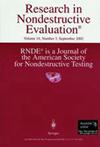用于显示平面上电磁波功率密度的调频热波成像
IF 1.6
4区 材料科学
Q3 MATERIALS SCIENCE, CHARACTERIZATION & TESTING
引用次数: 0
摘要
本文首次介绍了调频热波成像技术(FMTWI)[1-6],用于确定电磁波在平面上的功率分布。这种技术的优点是我们可以从一次实验中提取多个振幅和相位图像。在该技术中,应用的激励信号是一个调频啁啾信号,而不是传统红外(IR)热成像中使用的单频信号[7-11]。利用FMTWI获得的热图像可以定性地使用,例如,用于检测电磁结和微带馈线附近的场泄漏。作为该技术的实际演示,以8ghz频段的2 × 2贴片天线阵列为例。首先,得到不同调制频率下的幅值图像。接下来,计算每个频率的信噪比(SNR)值。可以看出,在较高的频率,信噪比较低。观察到,在较高的调制频率下,馈送阵列的各个贴片天线的微带线在幅值图像中不可见,而在较低的频率下,它们清晰可见,微波吸收屏的数学建模也被进行,以显示入射、反射和发射功率的变化作为屏面阻抗的函数。还观察到,屏幕对电磁场的干扰最小。本文章由计算机程序翻译,如有差异,请以英文原文为准。
Frequency modulated thermal wave imaging for visualizing power density of electromagnetic waves on plane surfaces
ABSTRACT In this article, Frequency Modulated Thermal Wave Imaging (FMTWI) [1–6] is introduced for the first time for determining power distribution of electromagnetic waves on plane surfaces. The advantage with this technique is that we can extract multiple amplitude and phase images from a single run of experiment. The applied excitation signal in this technique is a frequency modulated chirp signal instead of a single frequency signal used in conventional lock-in infrared (IR) thermography [7–11]. The thermal images obtained using FMTWI can be used qualitatively, e.g., to detect field leakage near electromagnetic junctions and microstrip feed lines. As a practical demonstration of this technique, an example of 2 × 2 patch antenna array at 8 GHz is considered. First, amplitude images at various modulation frequencies are obtained. Next, signal to noise ratio (SNR) values at each frequency are calculated. It is seen that SNR is lower at higher frequencies. It is observed that at higher modulation frequencies, micro-strip lines feeding the individual patch antennas of the array, are not visible in amplitude images, while at lower frequencies they are clearly visible Mathematical modeling of the microwave absorption screen has also been carried out to show variations of incident, reflected, and transmitted powers as a function of screen surface impedance. It is also observed that the screen minimally perturbs the electromagnetic fields.
求助全文
通过发布文献求助,成功后即可免费获取论文全文。
去求助
来源期刊

Research in Nondestructive Evaluation
工程技术-材料科学:表征与测试
CiteScore
2.30
自引率
0.00%
发文量
14
审稿时长
>12 weeks
期刊介绍:
Research in Nondestructive Evaluation® is the archival research journal of the American Society for Nondestructive Testing, Inc. RNDE® contains the results of original research in all areas of nondestructive evaluation (NDE). The journal covers experimental and theoretical investigations dealing with the scientific and engineering bases of NDE, its measurement and methodology, and a wide range of applications to materials and structures that relate to the entire life cycle, from manufacture to use and retirement.
Illustrative topics include advances in the underlying science of acoustic, thermal, electrical, magnetic, optical and ionizing radiation techniques and their applications to NDE problems. These problems include the nondestructive characterization of a wide variety of material properties and their degradation in service, nonintrusive sensors for monitoring manufacturing and materials processes, new techniques and combinations of techniques for detecting and characterizing hidden discontinuities and distributed damage in materials, standardization concepts and quantitative approaches for advanced NDE techniques, and long-term continuous monitoring of structures and assemblies. Of particular interest is research which elucidates how to evaluate the effects of imperfect material condition, as quantified by nondestructive measurement, on the functional performance.
 求助内容:
求助内容: 应助结果提醒方式:
应助结果提醒方式:


